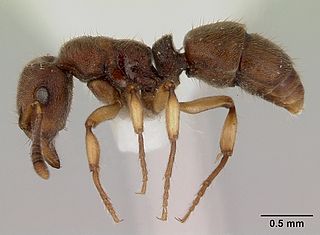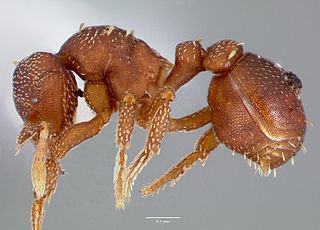Related Research Articles

Heteroponera brouni is a species of ant in the genus Heteroponera. It is endemic to the North Island of New Zealand, and the Three Kings Islands.

Acanthognathus is a genus of ants that are found in tropical Central and South America. There are 7 living species and 1 extinct species, Acanthognathus poinari, known only from fossil records.

Procryptocerus is a Neotropical genus of gliding ants, with the ability to "parachute" by steering their fall if they drop off of the tree they're on.

Agroecomyrmecinae is a subfamily of ants containing two extant and two fossil genera. The subfamily was originally classified in 1930 by Carpenter as Agroecomyrmecini, a Myrmicinae tribe. Bolton raised the tribe to subfamily status in 2003, suggesting that Agroecomyrmecinae might be the sister taxon to Myrmicinae. It has since been discovered to be one of the earliest lineages of ants, a clade from the basal polytomy for all ants. In 2014, the subfamily was expanded to two tribes. The tribe Ankylomyrmini was moved from the subfamily Myrmicinae to Agroemyrmecinae.

Tatuidris, or armadillo ant, is a rare genus of ants consisting of a single species, Tatuidris tatusia. The ants are small in size and inhabit the leaf litter of Neotropical forests in Central and South America, from Mexico to Brazil. Workers are ferruginous-colored to dark red and present a distinctive morphology, consisting of a shield-like head with a broad vertex, ventrally-turned heavy mandibles which do not overlap at full closure, and unique among ants – an antenna socket apparatus sitting upside-down. Little is known about the biology of the ants, but they are likely nocturnal and specialist predators.

Gnamptogenys is a genus of ants in the subfamily Ectatomminae. The genus has a wide distribution. It is known to occur in the Nearctic, Neotropic, Indomalayan and Australasian realms.

Heteroponera is a genus of ants in the subfamily Heteroponerinae. The genus is known from the Neotropics and Australasia.

Eurhopalothrix is a genus of ants in the subfamily Myrmicinae.

Acanthognathus ocellatus is a species of ant belonging to the genus Acanthognathus. Described in 1969 by Brown & Kempf, the species is native to South America.
Acanthognathus stipulosus is a species of ant of the genus Acanthognathus. Described in 1969 by Brown & Kempf, the species is native to South America.

Acanthognathus teledectus is a species of ant belonging to the genus Acanthognathus. Described in 1969 by Brown & Kempf, the species is native to Central America.
Heteroponera crozieri is a species of ant in the genus Heteroponera endemic to Australia. Described in 2011, the workers look similar to those of Heteroponera leae, although H. leae ants are more southerly distributed.

Heteroponera flava is a species of ant in the genus Heteroponera. Endemic to Brazil and Paraguay, it was described by Kempf in 1962.

Heteroponera inca is a species of ant in the genus Heteroponera. Endemic to Colombia, it was described by William Louis Brown Jr. in 1958.
Heteroponera inermis is a species of ant in the genus Heteroponera. Endemic to Brazil, it was described by Emery in 1894.
Heteroponera leae is a species of ant in the genus Heteroponera. It is endemic to Australia, and was described by Wheeler in 1923. It has a similar appearance to Heteroponera crozieri ants, although H. crozieri ants are more northerly distributed.

Heteroponera mayri is a species of ant in the genus Heteroponera. Endemic to Brazil and Paraguay, it was described by Kempf in 1962.

Heteroponera panamensis is a species of ant in the genus Heteroponera. Endemic to Costa Rica and Panama, It was described by Forel in 1899.
Heteroponera relicta is a species of ant in the genus Heteroponera. Endemic to Australia, it was described by Wheeler in 1915.
Heteroponera robusta is a species of ant in the genus Heteroponera. Endemic to Brazil, it was described by Kempf in 1962.
References
- ↑ Kempf, W. W.; Brown, W. L., Jr. 1970. Two new ants of tribe Ectatommini from Colombia (Hymenoptera: Formicidae). Stud. Entomol. 13: 311-320 (page 312, figs. 1, 2 worker described)
| This ant-related article is a stub. You can help Wikipedia by expanding it. |